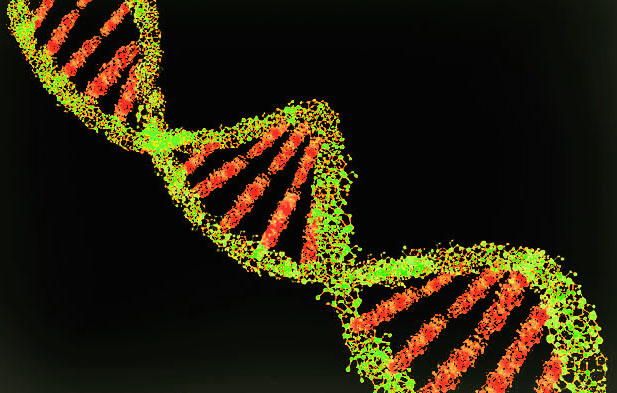Small genes, big implications
The human microbiome is overflowing with more genetic information than we thought
Leto Sapunar • December 21, 2019

A rendering of the molecular structure of DNA. Small genes have fewer nucleotides — shown in red — and a shorter DNA structure. [Credit: quapan/Flickr |CC]
“Small” genes hiding within the human microbiome may be the foundation of a cellular language, despite being largely ignored until now, according to a recent study.
Small genes are chains of 50 or fewer nucleotides — the molecules that make up DNA. These genes contain instructions for making small proteins and are more difficult to recognize and generally considered less important than larger genes, which are thought to hold most inherited genetic information.
But a research group at Stanford University, led by Hila Sberro, a post-doctoral fellow in microbial genetics there, is upending the traditional approach in order to look more closely at the genes inside the human microbiome — the ecosystem of beneficial microbes that live inside us.
Unlike in human cells, genes in the microbiome are freely and constantly exchanged between microbes. It forms what Sberro calls a “soup of genes.”
Sberro and her group’s analysis of small genes, published in August in the journal Cell, concluded that more than 30% of small genes they cataloged control how cells communicate with other cells.
That’s noteworthy because the molecules released by communicating bacteria can be so similar to those used in human cells. So similar, in fact, that the human cells can’t tell the difference, Sberro says.
Understanding this “language” that microbes use amongst themselves — and possibly to interact with us — could help us learn the specific ways microbiomes affect our health, she adds.
The researchers used publicly available genetic information from an online archive for their analysis. They specifically looked at data collected from gut, skin, mouth and vaginal microbiomes. Analyzing small genes tends to produce many more errors than studies of larger genes. According to Sberro, this is because the groups of molecules which signal the start and end of the gene sequence are so close together that it’s easy to confuse where a gene truly starts and ends. By using an algorithm to look for patterns of recurring small genes, Sberro and her colleagues were able to filter through the mass of data and separate many of the authentic small genes from the false readings.
This process involved going through data others had already recorded from human microbiomes to find small gene signals that were skipped over in other analyses. The team, in turn, made their data freely accessible so other groups can study the newly discovered genes.
A microbial geneticist not involved in the study, Jack Gilbert of the University of California, San Diego, calls the Stanford group’s analysis “robust and appropriate.” The newly accessible data on small genes, he adds, will be an excellent resource for researchers — especially those who don’t have access to the computing power required to do this kind of analysis on their own.
Small genes could also be an avenue for developing novel antibiotics — a pressing concern in modern health care. Some of the small proteins released in the microbial soup might have antibacterial properties and be able to target specific bacterial proteins the way some antibiotics do, according to Sberro.
Dr. Ami Bhatt who oversaw Sberro’s work and studies microbe-human interaction at Stanford, hopes the study and online archive of small gene information will prompt other geneticists to take a fresh look at information within the microbiome. Bhatt says of small genes and the proteins they encode, “there are lots of them and we probably shouldn’t be overlooking them.”